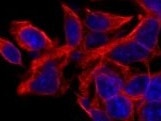Human GDF-11/BMP-11 Antibody Summary
Asn299-Ser407
Accession # O95390
Applications
Please Note: Optimal dilutions should be determined by each laboratory for each application. General Protocols are available in the Technical Information section on our website.
Scientific Data
 View Larger
View Larger
GDF‑11/BMP‑11 in HEK293 Human Cell Line. GDF-11/BMP-11 was detected in immersion fixed HEK293 human embryonic kidney cell line transfected with GDF-11 using Mouse Anti-Human GDF-11/BMP-11 Monoclonal Antibody (Catalog # MAB19583) at 10 µg/mL for 3 hours at room temperature. Cells were stained using the NorthernLights™ 557-conjugated Anti-Mouse IgG Secondary Antibody (red; Catalog # NL007) and counterstained with DAPI (blue). Specific staining was localized to cytoplasm. View our protocol for Fluorescent ICC Staining of Cells on Coverslips.
Reconstitution Calculator
Preparation and Storage
- 12 months from date of receipt, -20 to -70 °C as supplied.
- 1 month, 2 to 8 °C under sterile conditions after reconstitution.
- 6 months, -20 to -70 °C under sterile conditions after reconstitution.
Background: GDF-11/BMP-11
Growth Differentiation Factor 11 (GDF-11), also known as BMP-11, is a member of the TGF-beta superfamily and is highly related to GDF-8. GDF-11 encodes a 407 amino acid (aa) prepropeptide which contains a signal sequence for secretion and an RXXR proteolytic processing site to yield a 109 aa residue carboxy-terminal mature protein (1). Mature GDF-11 contains the canonical 7-cysteine motif common to other TGF-beta superfamily members; however, like the TGF-beta s, Activins and GDF-8, GDF-11 also contains one extra pair of cysteine residues. At the amino acid sequence level, mature human, mouse, rat and chicken GDF-11 are 99-100% identical. GDF-11 and GDF-8 share 90% amino acid sequence identity within the mature protein. As detected by in situ hybridization, GDF-11 is expressed in diverse regions of the mouse embryo: tailbud, somitic precursors, limbs, mandibular and branchial arches, dorsal neural tube, odontoblasts, nasal epithelium, and particular regions of the brain (1, 2). Targeted deletion of GDF-11, in mice, results in a spectrum of abnormalities including palatal malformation, vertebral defects, elongated trunks with a reduced or absent tail, missing or malformed kidneys, and an increased number of neurons in the olfactory epithelium (2-5). GDF-11 signals through the Activin type II receptors and induces phosphorylation of Smad2 to mediate axial patterning (6). Systemic GDF-11 levels decline with age and administration of higher levels of GDF-11 can reverse age-related cardiac hypertrophy (7). In addition, systemic administration of recombinant GDF-11 protein restores genomic integrity and health of muscle stem cells, neurovasculature and enhances neurogenesis (8, 9).
- Gamer, L.W. et al. (1999) Dev. Biol. 208: 222.
- Nakashima, M. et al. (1999) Mech. Dev. 80:185.
- Gad, J.M. and P.P.L. Tam (1999) Curr. Biol. 9:R783.
- McPherron, A.C. et al. (1999) Nat. Genet. 22:260.
- Esquela, A.F. and S.J. Lee (2003) Dev. Biol. 257:356.
- Oh, S.P. et al. (2002) Genes & Dev. 16:274.
- Loffredo, F.S. et. al. (2013) Cell. 153.828.
- Katsimpardi, L. et. al. (2014) Science (ahead of print).
- Sinha, M. et. al. (2014) Science (ahead of print).
Product Datasheets
FAQs
No product specific FAQs exist for this product, however you may
View all Antibody FAQsReviews for Human GDF-11/BMP-11 Antibody
Average Rating: 5 (Based on 1 Review)
Have you used Human GDF-11/BMP-11 Antibody?
Submit a review and receive an Amazon gift card.
$25/€18/£15/$25CAN/¥75 Yuan/¥2500 Yen for a review with an image
$10/€7/£6/$10 CAD/¥70 Yuan/¥1110 Yen for a review without an image
Filter by:


